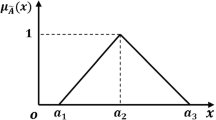Abstract
The class of fuzzy linear fractional optimization problems with fuzzy coefficients in the objective function is considered in this paper. We propose a parametric method for computing the membership values of the extreme points in the fuzzy set solution to such problems. We replace the exhaustive computation of the membership values—found in the literature for solving the same class of problems—by a parametric analysis of the efficiency of the feasible basic solutions to the bi-objective linear fractional programming problem through the optimality test in a related linear programming problem, thus simplifying the computation. An illustrative example from the field of production planning is included in the paper to complete the theoretical presentation of the solving approach, but also to emphasize how many real life problems may be modelled mathematically using fuzzy linear fractional optimization.




Similar content being viewed by others
References
Biswas, A., & Bose, K. (2012). Application of fuzzy programming method for solving nonlinear fractional programming problems with fuzzy parameters. In P. Balasubramaniam & R. Uthayakumar (Eds.), Mathematical modelling and scientific computation, communications in computer and information science (Vol. 283, pp. 104–113). Berlin: Springer.
Cadenas, J. M., & Verdegay, J. L. (1997). Using fuzzy numbers in linear programming. IEEE Transactions on Systems, Man and Cybernetics Part B—Cybernetics, 27(6), 1016–1022. doi:10.1109/3477.650062.
Chalco-Cano, Y., Lodwick, W. A., Osuna-Gómez, R., & Rufián-Lizana, A. (2015). The karushkuhntucker optimality conditions for fuzzy optimization problems. Fuzzy Optimization and Decision Making,. doi:10.1007/s10700-015-9213-9.
Chanas, S., & Kuchta, D. (1994). Linear programming problem with fuzzy coefficients in the objective function. In M. Delgado, J. Kacprzyk, J. Verdegay, & M. Vila (Eds.), Fuzzy optimization (pp. 148–157). Berlin: Physica-Verlag.
Dempe, S., & Ruziyeva, A. (2012). On the calculation of a membership function for the solution of a fuzzy linear optimization problem. Fuzzy Sets and Systems, 188, 58–67. doi:10.1016/j.fss.2011.07.014.
Dubois, D., & Prade, H. (2012). Gradualness, uncertainty and bipolarity: Making sense of fuzzy sets. Fuzzy Sets and Systems, 192, 3–24. doi:10.1016/j.fss.2010.11.007.
Dziţac, I. (2015). The fuzzification of classical structures. International Journal of Computers, Communications & Control, 10(6), 771–787. doi:10.15837/ijccc.2015.6.2069.
Ehrgott, M. (2005). Multicriteria optimization. Berlin: Springer.
Frenk, J. B. G., & Schaible, S. (2005). Fractional programming. In N. Hadjisavvas, S. Komlosi, & S. Schaible (Eds.), Handbook of generalized convexity and generalized monotonicity, nonconvex optimization and its applications (Vol. 76, pp. 335–386). New York: Springer.
Kaur, J., & Kumar, A. (2013). A new method to find the unique fuzzy optimal value of fuzzy linear programming problems. Journal of Optimization Theory and Applications, 156(2), 529–534. doi:10.1007/s10957-012-0132-4.
Khan, I., Ahmad, T., & Maan, N. (2013). A simplified novel technique for solving fully fuzzy linear programming problems. Journal of Optimization Theory and Applications, 159(2), 536–546. doi:10.1007/s10957-012-0215-2.
Kheirfam, B., & Verdegay, J. L. (2013). The dual simplex method and sensitivity analysis for fuzzy linear programming with symmetric trapezoidal numbers. Fuzzy Optimization and Decision Making, 12, 171–189. doi:10.1007/s10700-012-9152-7.
Liu, S. T. (2015). Fractional transportation problem with fuzzy parameters. Soft Computing,. doi:10.1007/s00500-015-1722-5.
Lodwick, W. A. (Ed.). (2010). Fuzzy optimization. New York: Springer.
Lotfi, F. H., Noora, A. A., Jahanshahloo, G. R., Khodabakhshi, M., & Payan, A. (2010). A linear programming approach to test efficiency in multi-objective linear fractional programming problems. Applied Mathematical Modelling, 34, 4179–4183. doi:10.1016/j.apm.2010.04.015.
Moore, R. E. (1966). Interval analysis. Englewood Cliffs, New Jersey: Prentice-Hall.
Pop, B., & Stancu-Minasian, I. M. (2008). A method of solving fully fuzzified linear fractional programming problems. Journal of Applied Mathematics and Computing, 27(1–2), 227–242. doi:10.1007/s12190-008-0052-5.
Razavi, S., Amoozad, H., Zavadskas, E., & Hashemi, S. (2013). A fuzzy data envelopment analysis approach based on parametric programming. International Journal of Computers, Communications & Control, 8(4), 594–607. doi:10.15837/ijccc.2013.4.580.
Rommelfanger, H., & Slowinski, R. (1998). Fuzzy linear programming with single or multiple objective functions. In R. Slowinski (Ed.), Fuzzy sets in decision analysis, operations research and statistics (pp. 179–213). Berlin: Kluwer Academic Publishers.
Silva, R. C., Cruz, C., & Verdegay, J. L. (2013). Fuzzy costs in quadratic programming problems. Fuzzy Optimization and Decision Making, 12, 231–248. doi:10.1007/s10700-013-9153-1.
Stancu-Minasian, I. M. (1997). Fractional programming: Theory, methods and applications. Berlin: Kluwer Academic Publishers.
Stanojević, B. (2015). Extended procedure for computing the values of the membership function of a fuzzy solution to a class of fuzzy linear optimization problems. Fuzzy Sets and Systems, 272, 47–59. doi:10.1016/j.fss.2014.11.002.
Stanojević, B., Dziţac, I., & Dziţac, S. (2015). On the ratio of fuzzy numbers—exact membership function computation and applications to decision making. Technological and Economic Development of Economy, 21(5), 815–832. doi:10.3846/20294913.2015.1093563.
Stanojević, B., & Stancu-Minasian, I. M. (2012). Evaluating fuzzy inequalities and solving fully fuzzified linear fractional program. Yugoslav Journal of Operations Research, 22, 41–50. doi:10.2298/YJOR110522001S.
Stanojević, B., & Stanojević, M. (2013). Parametric computation of a membership function for the solution of a fuzzy linear fractional optimization problem. In N. Mladenović, G. Savić, M. Kuzmanović, D. Makajić-Nikolić, & M. Stanojević (Eds.), Proceedings of the 11th Balkan conference on operational reasearch (pp. 507–513). Santa Barbara: Newpress.
Stanojević, B., & Stanojević, M. (2013). Solving method for linear fractional optimization problem with fuzzy coefficients in the objective function. International Journal of Computers, Communications & Control, 8, 146–152.
Uhrig, R., & Tsoukalas, L. (1997). Fuzzy and neural approaches in engineering. Hoboken: Wiley.
Zimmermann, H. J. (1985). Applications of fuzzy set theory to mathematical programming. Information Sciences, 36(1), 29–58. doi:10.1016/0020-0255(85)90025-8.
Zimmermann, H. J. (1996). Fuzzy set theory and its applications. Berlin: Kluwer Academic Publishers.
Acknowledgments
This research was partially supported by the Ministry of Education and Science, Republic of Serbia, Project numbers TR36006 and TR32013. The authors want to express their gratitude to the anonymous referees for their valuable suggestions and remarks.
Author information
Authors and Affiliations
Corresponding author
Rights and permissions
About this article
Cite this article
Stanojević, B., Stanojević, M. Parametric computation of a fuzzy set solution to a class of fuzzy linear fractional optimization problems. Fuzzy Optim Decis Making 15, 435–455 (2016). https://doi.org/10.1007/s10700-016-9232-1
Published:
Issue Date:
DOI: https://doi.org/10.1007/s10700-016-9232-1




